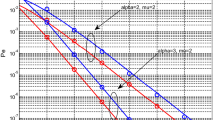Abstract
Error rate probability is considered as important metric to evaluate the behavior of communication system. Gaussian Q-function is gaining more intention from researchers due to its direct relation in computing the error probability in terms of symbol error rate (SER) or bit error rate. In literature, several approximated functions have been proposed to evaluate and analyze the error rate in fading channel. In this paper, a novel, simple and accurate closed form for Gaussian Q-function is derived. In contrast to previous related approximated functions; it is noticeable that the designed formula improves the accuracy for large range of positive argument. Furthermore, an efficient SER formula is derived for additive white Gaussian noise and for Rayleigh fading channel. Numerical analysis and simulation were conducted to verify and validate the designed approximated functions. The results show that the proposed form can achieve high accuracy compared to that of previous work; and also simplify the evaluation analysis of SER in fading channels.







Similar content being viewed by others
References
Dhungana, Y., & Tellambura, C. (2012). New simple approximations for error probability and outage in fading. IEEE Communications Letters, 16, 1760–1763.
Alkurd, R., Abualhaol, I., & Muhaidat, S. (2013). An efficient approximation of Q(\(\sqrt{x}\)) function and general BER performance analysis. In 2013 7th IEEE GCC Conference and Exhibition (GCC) (pp. 367–371).
Goldsmith, A. J., & Chua, S.-G. (1997). Variable-rate variable-power MQAM for fading channels. IEEE Transactions on Communications, 45, 1218–1230.
Goldsmith, A. (2005). Wireless communications. Cambridge: Cambridge University Press.
Alouini, M.-S., & Goldsmith, A. (2000). Adaptive modulation over Nakagami fading channels. Wireless Personal Communications, 13, 119–143.
Karagiannidis, G. K., & Lioumpas, A. S. (2007). An improved approximation for the Gaussian Q-function. IEEE Communications Letters, 11, 644–646.
Kalansuriya, P., & Tellambura, C. (2009). Performance analysis of decode-and-forward relay network under adaptive M-QAM. In Proceeding of IEEE International Conference on Communications (ICC09), Dresden.
Simon, M. K., & Alouini, M.-S. (2005). Digital communication over fading channels (Vol. 95). New York: Wiley.
Craig, J.W. (1991). A new, simple and exact result for calculating the probability of error for two-dimensional signal constellations. In Conference Record, Military Communications in a Changing World Military Communications Conference, 1991 (MILCOM’91) (Vol. 2, pp. 571-575). IEEE.
Chiani, M., Dardari, D., & Simon, M. K. (2003). New exponential bounds and approximations for the computation of error probability in fading channels. IEEE Transactions on Wireless Communications, 2, 840–845.
Smith, R. T., & Minton, R. B. (2007). Calculus: Early transcendental functions. AMC, 10, 12.
Chandrasekharamenon, N. P., & AnchareV, B. (2012). Connectivity analysis of one-dimensional vehicular ad hoc networks in fading channels. EURASIP Journal on Wireless Communications and Networking, 2012, 1–16.
Carpenter, S.E. (2014). Obstacle shadowing influences in VANET safety. In 2014 IEEE 22nd International Conference on Network Protocols (ICNP) (pp. 480–482).
Miorandi, D. (2008). The impact of channel randomness on coverage and connectivity of ad hoc and sensor networks. IEEE Transactions on Wireless Communications, 7, 1062–1072.
Acknowledgments
The authors would like to thank the Univeristi Sains Malaysia for providing RUI Grant entitled Relative Velocity-based Forwarding Strategy For Vehicular Ad hoc Naetworks (1001/PNAV/814233) to fund this research project.
Author information
Authors and Affiliations
Corresponding author
Rights and permissions
About this article
Cite this article
Hanshi, S.M., Kadhum, M.M. & Wan, TC. Efficient Approximated Q-Function Form for Error Probability over Rayleigh Fading Channels. Wireless Pers Commun 89, 467–478 (2016). https://doi.org/10.1007/s11277-016-3282-0
Published:
Issue Date:
DOI: https://doi.org/10.1007/s11277-016-3282-0




